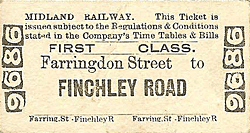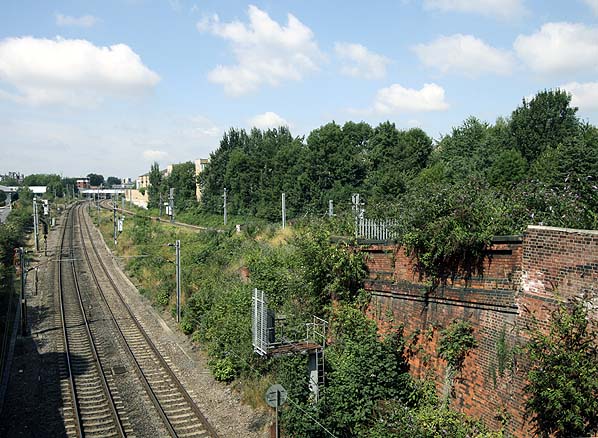Notes: The Midland Railways London Extension into St. Pancras was ready for inspection in July 1868 but the Board of Trade inspector refused to sanction the opening of St. Pancras itself because the approaches to the station were, at that time unfinished.
 |
The inspector was however happy with the rest of the line and agreed to the opening of the line between Bedford and Camden Town where there was a junction that allowed trains to run into the Metropolitan Line's station at Moorgate Street. The line was opened between Bedford and Moorgate street on 13th July 1868 with intermediate stations with the London area |
at Hendon, Finchley Road & St Johns Wood, Haverstock Hill, Kentish Town and Camden Road. Work on the approaches to St. Pancras continued and the station finally opened on 1st October 1868.
Although the station opened as ‘Finchley Road & St John’s Wood’ the suffix was quickly dropped from timetables although it continued to appear on at least one platform nameboard.
The station comprised two platforms and had its entrance on the west side of Finchley Road. The brick building which housed the booking office had living accommodation on its upper floor. It was at an intermediate level and was accessed from Finchley Road by means of a short pathway and a flight of steps, which led into the ticket hall. From here, passengers requiring the up platform descended a stairway, whilst those wishing to catch a down train crossed above the tracks by means of a footbridge. The platform buildings were located towards the London end, with those on the up side being more extensive than on the down.
 |
Immediately south of the premises lay a goods yard, which was accessed from the north end and is understood to have opened on the same day as the passenger station. In 1878, a siding was laid to connect this with the Metropolitan Railway, which was then in the process of extending its route from Swiss Cottage to West Hampstead and beyond. This was only intended as a temporary arrangement for the conveyance of building materials, but two years later, on 1st October 1880, the connection was made permanent to provide an exchange siding between the two companies. Finchley Road signal box stood on the south side of the formation, between the goods lines and the yard.
| In order to eliminate a bottleneck where the two passenger lines and two freight lines interlaced into two lines to pass through Belsize Tunnel at the east end of the station a new tunnel for the passenger lines on the north side of the line was constructed in 1884. As the original platforms faced what were now the goods lines, one was abandoned and the other was widened |
 |
to serve the new down line and a new up platform was built. The original booking office above was retained. Externally it was unaltered but there were some internal changes.
The two new platforms were backed by red brick walls with glazed awnings supported on iron columns. There was a large building incorporating a waiting room, gents toilet, porters room, lamp room and coal store on the 'down' platform all accessed through doorways in the wall with a smaller building incorporating a waiting room and another gents toilet on the up platform. Unusually there were no ladies facilities; there was originally a ladies room in the booking office but this appears to have been changed during the alterations when the room became a new stationmaster's office.
The old platforms were closed and the new platforms were brought into use on 3rd February 1884 before the Board of Trade inspection which didn't take place until 1st April at which time improvements to the signalling were required. The old down platform was demolished before closure of the station but the old up platform which was now separated from the new down face by the wall was retained.
The 1884 signalbox was replaced on 21st May 1905 and at about this time the Midland Railway decided to redevelop the street level entrance which just consisted of steps down to the booking office. A new iron gateway was provided flanked by two groups of coal offices. In total seven offices or shops were built in a semicircle around the station gateway and these were known as Midland Crescent.
 |
The station was always well used, reaching a peak in 1898 when 87,592 tickets were issued. Following the turn of the century and the introduction of more convenient road transport ticket sales had plummeted to 15,378 in 1915. The other Midland Inner London stations at Haverstock Hill and Camden Road were doing equally badly and these closed in January 1916 |
but Finchley Road remained open and although there was a brief recovery by 1922 ticket sales had dropped back to 5870 and four years after the grouping the LMS decided it could no longer justify keeping the station open and the station closed on 11th July 1927. The goods yard remained open.
The awnings were quickly removed but the station remained largely intact into the 1960s. The former booking office was let out as a workshop. Demolition took place piecemeal over the next 40 years with the platforms being further cut back and the booking office demolished during electrification of the line to Bedford in 1982. The yard continued to deal with coal traffic until 16th May 1983. The gateway onto Finchley Road survived into the twenty-first century, as did ‘Midland Crescent’, but these have now gone. What remains today is probably best seen from a passing train and includes sections of the red brick walling and much of the 1868 up side stairway.
Sources: The Midland Railway by J E Connor. Published 2009 by Connor & Butler. ISBN 978 0 947699 42 2
Ticket from Michael Stewart, timetable from Glynn Waite, route map drawn by Alan Young
For other Midland Railway London suburban stations click on the station name: Hendon Factory Platform, Welsh Harp, Haverstock Hill, Camden Road,
Dudding Hill & Harlesden for West Willesden & Stonebridge Park |

road_old3.jpg)

road_old1.jpg)
road13.jpg)
road1.jpg)
road2.jpg)
road5.jpg)






road_old_thumb5.jpg)
road_old_thumb2.jpg)
road_old_thumb4.jpg)
road_thumb11.jpg)
road_thumb12.jpg)
road_thumb3.jpg)
road_thumb4.jpg)
road_thumb10.jpg)
road_thumb6.jpg)
road_thumb7.jpg)
road_thumb8.jpg)
road_thumb9.jpg)
road_thumb15.jpg)

 Home Page
Home Page